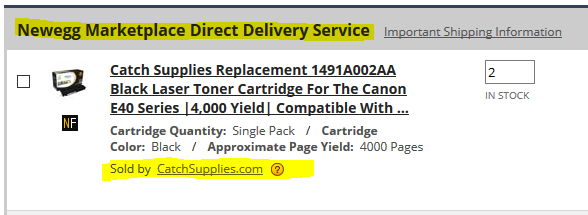This is a new series of posts that point out issues and problems with camera- related shopping, practices and things that are not very consumer-friendly, or not as consumer-friendly as they could be. This is not only for the benefit of consumers, but also for retailers who are in it for the long haul. The happier your consumers, the more sales, and more loyal customers you get, and the more they spread the word longer and wider.
We start with a relatively new trend with open marketplaces which allow many 3rd-party merchants to sell the same product: the marketplace won’t tell you upfront or will make it hard to figure (without either proceeding all the way in the ordering process, or even after completing an order) who the actual seller of the product is.
The poster-child of this phenomenon is Jet.com. Not only did they have lots of funding when they were independent, but also got a giant infusion of cash when they got purchased by Walmart [see Crunchbase for details], so it’s not like they don’t have the money or infrastructure to do this. I understand the need to simplify the product page and not have it be a circus like a typical Amazon product page. Jet also simplifies the shipping process, where you just buy things, and you don’t have to worry about paying multiple shipping fees depending on the seller. This is good and innovative, and a way to help the consumer save money. Certainly not an issue if you are buying small things and books and music CDs and such.
However what is a plus for small purchases, becomes a big negative for things like camera gear. The actual seller of a product is very important when you are buying an expensive item or an item where authorized dealer status dictates whether you get warranty service or not. And that’s before we consider counterfeit products. Or unreliable and disreputable dealers who try to sneak in opened and used products as brand new or remove accessories. And the list goes on of potential issues when you are not dealing with an A-list dealer.
Considering all the shenanigans we know (and not love) about camera gear selling, and some sellers being less reputable and reliable than others, this is a big wild card and risk for the buyer.
Jet is not alone
Jet is not the only one. NewEgg’s FLASH sales website (NewEggFlash) is not as bad as Jet, but when you go to a product page, the actual seller of a product is hidden. You have to decode the “Return Policy” to guess who the actual seller is. Thankfully this becomes more obvious _AFTER_ you add an item to the shopping cart, but that’s still not good enough.
Here are a couple of screenshots, used under fair use as an example of the consumer issue at hand. The first is when NewEggFlash itself is the seller, the second is when a marketplace seller is the actual seller:


So the above is a trick to figure this out, not an official way. And that’s assuming that the seller is the one offering the “Return Policy”. But once you add the item to the shopping cart, the seller becomes formally visible:

Unintentionally Buying from Marketplace sellers is Still a General Issue
There are still people who unintentionally buy from marketplace sellers (instead of the house), even when the seller is shown in the listings. Partly this is user error, but it’s also up to the marketplaces to make it more obvious and easier to detect for the average consumer. Even with Amazon, who has been around since the early days of the consumer internet, and clearly marks the seller of record in their listings, there are still people who accidentally buy something from a marketplace seller and only realize this when they have to return something or when they have a problem.
So all retailers need to work to improve on this. And we, as consumers, need to pay more attention, while the winds of multi-tasking are pulling us in a dozen different directions 🙂